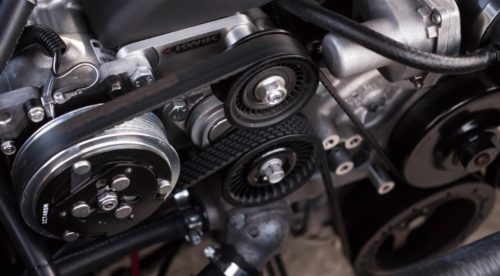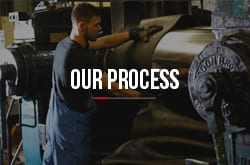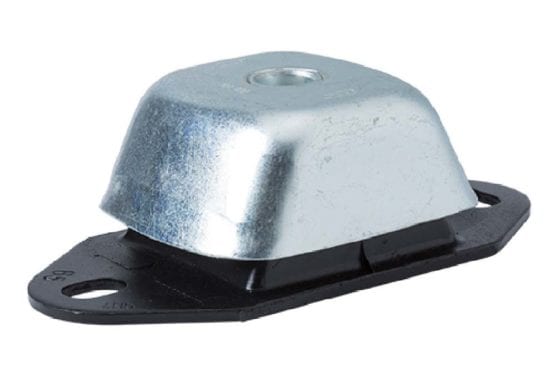5 Signs You Need to Replace Worn Engine Mounts
An engine mount’s primary purpose is to secure an engine into machinery and absorb any shocks and vibrations when the machinery is operating. Engine mounts and anti-vibration mounts are essential for preventing damage to the engine and improving operator comfort (where applicable). But what happens when engine mounts need replacing? And, do you know the symptoms of worn engine mounts? We answer both of these questions in this post.
How to Tell if Engine Mounts Need Replacing
Being aware of these symptoms of damaged/worn engine mounts will help you to identify when they need replacing:
1. Increased Vibrations
One of the most common engine mount symptoms is increased vibrations while using your vehicle. If you start your engine and notice that it is making more noise than usual and you can feel more vibrations than usual, this is a key sign of a worn engine mount that may need replacing. If an engine mount is damaged, its anti-vibration properties weaken. An increase in vibrations leads to the engine making more of a sound than usual – something that can be extremely damaging to an engine if it continues for a long time.
2. Rocky Start
Upon starting a machine, you may notice an excessive lurch that doesn’t feel or sound healthy. This is another one of the most common symptoms of worn engine mounts. This lurch often steadies into a constant vibration, but you may then also experience a lurch when turning the ignition off.
3. A Bumpier Ride
An engine mount that needs replacing can often cause a jolt when changing gears on an attached transmission. This jolt or thump can also be noticeable when travelling at faster speeds due to the engine working harder. If your machine doesn’t feel as smooth as usual, this can often be down to a damaged engine mount.
4. Impact Noises
Engine mount noise is a by-product of engine mount failure. A worn engine mount can often lead to ‘clunks’ and ‘bangs’ within its surroundings or within the engine bay. This noise is due to the engine moving around more than normal and making contact with other components, which in turn can cause impact sounds that become quite noticeable.
5. Visual Wear
With use, the metal part of an engine mount does change in appearance. However, if you can see any significant corrosion, cracks or warps to the part, excessive wear will likely be occurring to the rest of the mount. If you notice any cracks or flaking to the rubber aspect of an engine mount, this can potentially limit its performance depending on the severity of the cracks and the root cause. The effectiveness of engine mounts relies on their form and shape, as any changes can damage the engine. If you notice any of these signals, you should look into replacing engine mounts as quickly as possible.

Causes of Worn Engine Mounts
There are many reasons why your engine mounts may need replacing, some of the most common include:
1.Incorrect installation of the mounts
While you can install your engine mounts yourself, we recommend taking your vehicle to a reputable and qualified engineer as soon as you notice any signs your engine mounts need replacing. This ensures that your new fittings will be installed properly and last longer.
2. Ageing and weathering overtime
A common cause of engine mount failure is age and wear. Engine mounts are typically made of rubber, a material that is prone to wear over time and may lose its elasticity and, as a result, lessen its function to your engine. Age and stress can cause small cracks in fluid-filled engine mounts that can lead to leaks. As soon as you notice this has happened, made obvious by increased vibration and engine mount noise, you should replace your worn engine mount.
3. Driving techniques that can damage the vehicle’s parts
Over-revving the gears and improper use of the clutch can cause serious damage to your engine mounts. Practising proper driving techniques will extend the lifespan of your engine mounts and other vehicle components.
4. Accident involvement which has caused damage or moved the mounts
If you’ve been involved in an accident, you should always check for internal damage, such as engine mount failure, as well as superficial damage. Similarly, make sure you’re aware of a car’s road history before buying a new car and getting the right checks put in place before taking the vehicle to the road. Taking these precautions will help keep the machine operator safe.
5. Fluid leaks onto the mounts
If you notice any leaks in your motor, you should take your car for a service to fix the leak, and any other damage caused, no matter what the substance. For example, engine oil could cause the rubber to soften, leading to engine mount failure.
What Happens if I Don’t Change my Motor Mounts?
No matter the quality of your engine mounts, they all begin to wear down after usage and eventually require replacement. Not replacing an engine mount that is past its prime can lead to the following:
1.Road risk
If an engine mount breaks off from an engine, there will no longer be effective support. Damaged components can create a safety hazard for yourself and other motorists if other components break or fly off due to engine mount wear.
2. Damage to the engine
Engine movement or misalignment may occur as a result of engine mount failure. Broken or worn engine mounts may cause the engine to slide around in all directions in the engine bay, something that is particularly noticeable when accelerating or driving at high speeds.
3. Damage caused to other components
The vibration generated from worn engine mounts can have a noticeable impact on other vehicle components, such as fan belts or radiator hoses, leading to stretching or snapping. So, replacing worn engine mounts is vital to the overall health of your machine.
If you experience any of these symptoms of worn engine mounts or suspect any of the reasons above may be relevant to your vehicle, it’s best to get the engine checked out and consider replacing the engine mounts.
How Long do Engine Mounts Last?
Usually, engine mounts should last between at least 5-7 years, depending on the application. Still, we recommend getting them checked regularly when the vehicle is being serviced or when any other work is being carried out. This should maintain your engine and keep your driving experience as smooth as possible.
Should I Replace All Engine Mounts at Once?
While you don’t necessarily need to change all engine mounts at once, if you don’t replace them all, you should pay closer attention to them, as they’re likely to be the same age as the part you’re replacing. Therefore, you may need to take action soon because when one engine mount is damaged, more pressure is placed on all other mounts, which can accelerate the wear of these too. So, you may have to change more than one mount, if not all, engine mounts depending on how much damage has been caused.
At GMT Rubber, we are market leaders in engine mount technology. Our experience allows us to identify the right engine mounts for your needs. Contact us today if you would like any more information or assistance on when to replace engine mounts.










